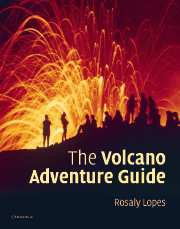Book contents
- Frontmatter
- Contents
- Preface
- Acknowledgments
- PART I Choosing a volcano to visit
- 1 Volcanoes of the World
- 2 The basic facts about volcanoes
- 3 Volcanic eruptions
- 4 Visiting volcanoes safely
- 5 Preparing and planning a volcano adventure
- PART II Guides to volcanoes
- Appendix I Useful information for preparing a volcano trip
- Appendix II Tours to volcanoes
- Bibliography
- Glossary
- Index
2 - The basic facts about volcanoes
from PART I - Choosing a volcano to visit
Published online by Cambridge University Press: 01 September 2010
- Frontmatter
- Contents
- Preface
- Acknowledgments
- PART I Choosing a volcano to visit
- 1 Volcanoes of the World
- 2 The basic facts about volcanoes
- 3 Volcanic eruptions
- 4 Visiting volcanoes safely
- 5 Preparing and planning a volcano adventure
- PART II Guides to volcanoes
- Appendix I Useful information for preparing a volcano trip
- Appendix II Tours to volcanoes
- Bibliography
- Glossary
- Index
Summary
What are volcanoes and how are they born?
The classic definition of a volcano is an opening on the Earth's surface from which magma emerges. Magma is molten rock containing dissolved gases and crystals, formed deep within the Earth. When a volcano erupts, magma – in the form of lava flows and lava fragments – builds a landform around the opening. This structure, which is often a hill or mountain, is also called a volcano. Most people think of volcanoes as tall mountains, either placid, snow-capped cones like Mt. Fuji in Japan or thundering, violent mountains that belch out towering clouds of ash and cinders, as Mt. St. Helens did in 1980. However, volcanoes come in many sizes and shapes and the character of their eruptions is highly diverse. Sometimes lava just pours out and floods a region, leaving no discernible hill, let alone a mountain. To understand why different types of volcanoes occur, we first have to look at how they relate to the Earth's mosaic of tectonic plates. Plate boundaries are the preferred locations for volcanoes and the types of eruption tend to be similar along each boundary. This is why we find similar volcanoes along each “itinerary” on our world tour.
- Type
- Chapter
- Information
- The Volcano Adventure Guide , pp. 18 - 27Publisher: Cambridge University PressPrint publication year: 2005

